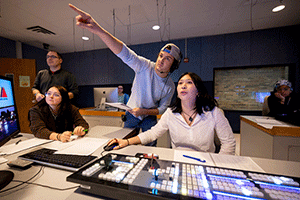Is a media arts degree the right choice for your creative career?
In today’s digital age, media is everywhere—on your screen, in your headphones and shaping the way we see the world. If you have a passion for storytelling, content creation and digital media, a media arts degree could be your gateway to a dynamic career in television, film, radio, news or sports broadcasting. But is this the right path for you? Let’s explore what a media arts major offers and how it can help you turn your creative ideas into professional productions.
From video production to working in the on-campus news or radio stations, discover what media arts looks like at Central Michigan University.
What can you do with a media arts degree?
A media arts degree is incredibly versatile, opening doors to various career paths in digital content creation, production and media performance. Whether you're interested in working behind the scenes or being in front of the camera, you’ll gain the skills needed to thrive in the media industry.
Graduates with a background in media arts have gone on to work for NBC News, CNN, Fox Sports, Netflix and other leading media companies. Career opportunities include:
- Film and video production: Work in cinematography, directing, or editing.
- Median annual salary: $66,600.
- Broadcasting: Become a news anchor, reporter, or sports broadcaster.
- Median annual salary: $58,920.
- Radio and podcasting: Develop your voice and produce compelling audio content.
- Median annual salary: $51,640.
- Media writing: Write scripts, screenplays, and digital content for various platforms.
- Median annual salary: $73,690.
- Music and audio production: Produce soundtracks, engineer audio, and work in the music industry.
- Median annual salary: $59,430.
- Digital content creation: Work in multimedia journalism, social media, and content marketing.
- Median annual salary: $58,920.
Salary data sourced from the U.S. Bureau of Labor Statistics.

What makes a media arts program stand out?
A strong media arts program provides students with real-world experience from day one. Hands-on training, access to industry-standard facilities and opportunities for networking all play a key role in preparing students for a successful media career.
Hands-on learning in industry-standard facilities
Learning goes beyond the classroom when students have access to practical experience in state-of-the-art facilities, including:
- Television stations: Create and broadcast shows to local cable and online platforms.
- Radio stations: Gain hands-on experience in radio broadcasting.
- News and sports broadcasting: Develop skills in live news and sports reporting.
- Media production studios: Work in audio and video production, film editing and digital content creation.

Build your network with industry connections
Networking is key in the media industry, and the right program provides numerous opportunities to connect with professionals. Through national organizations like the Radio Television Digital News Association and Alpha Epsilon Rho, students can meet industry leaders, attend media events and gain access to exclusive internships.
Join media-focused student organizations
Beyond coursework, student-run organizations offer collaboration with fellow creatives and hands-on experience:
- Film clubs: Connect with students who share a passion for film and media.
- National media honor societies: Join organizations that recognize excellence in media arts.
- Broadcasting & journalism associations: Engage with news professionals and fellow students interested in journalism and broadcasting.
Should you consider a media arts minor?
For students majoring in another field but wanting media production, storytelling or promotion skills, a media arts minor can be a valuable addition. Different programs may offer options tailored to degree paths:
- For students in creative and communication fields: A minor focused on content creation and production.
- For students in business-related fields: A minor emphasizing media promotion in business applications.

Ready to start your career in media?
A media arts degree equips you with the skills, experience and connections needed to break into the media industry. Whether your dream is to direct films, produce podcasts, report the news or create engaging content, the right program will provide the training and opportunities to turn your passion into a profession.
Central Michigan University offers a media arts program that delivers hands-on experience, industry connections, and real-world opportunities. Students gain practical skills in areas like audio and video production, media writing, sports broadcasting and multimedia journalism. With access to state-of-the-art facilities—including MHTV (a student-run television station), WMHW radio, and professional-grade recording studios—students can create, produce, and broadcast their own content. This immersive learning experience prepares graduates for careers in television, film, radio, corporate media and beyond. Explore the program today and take the first step toward your future in media!